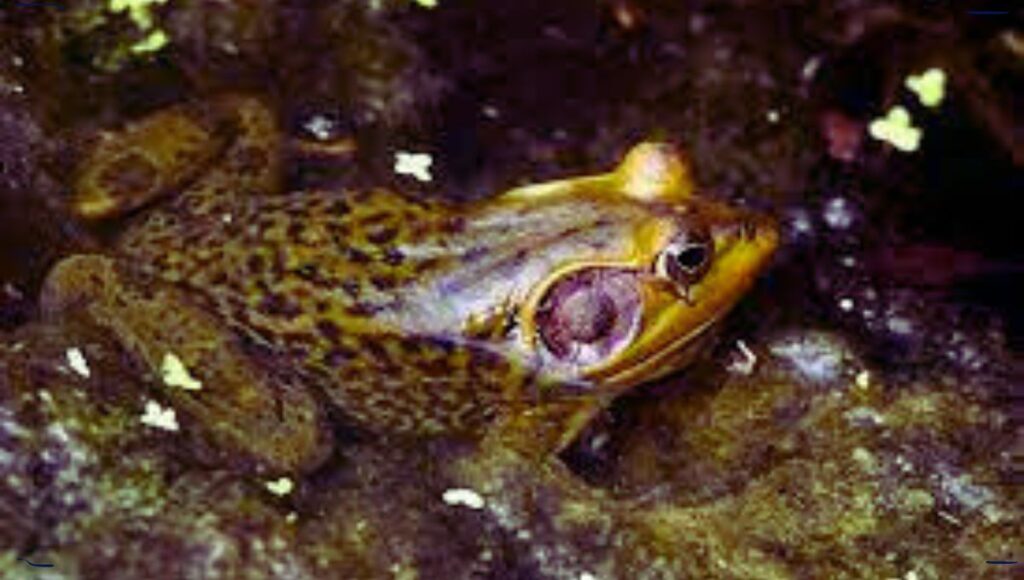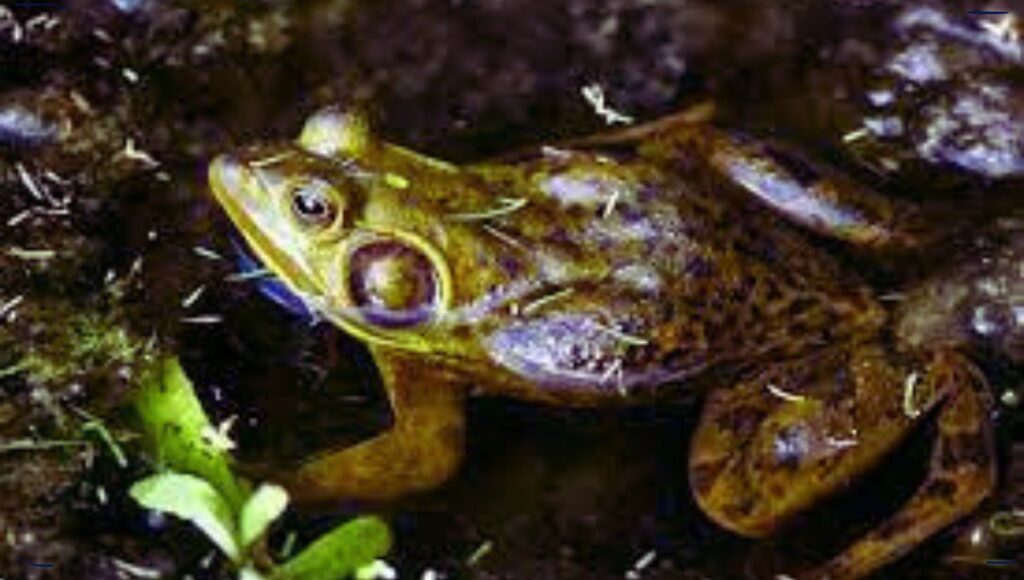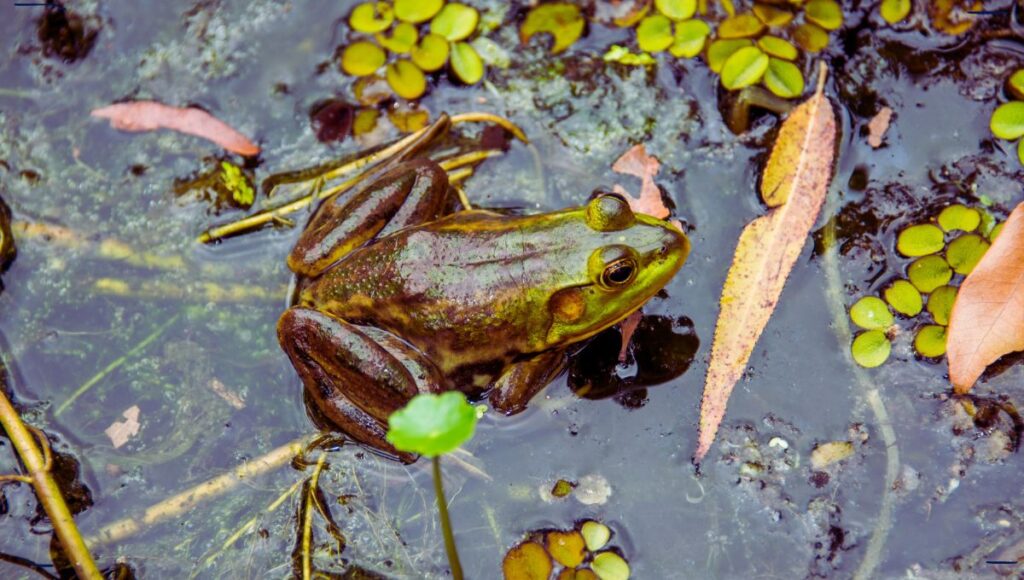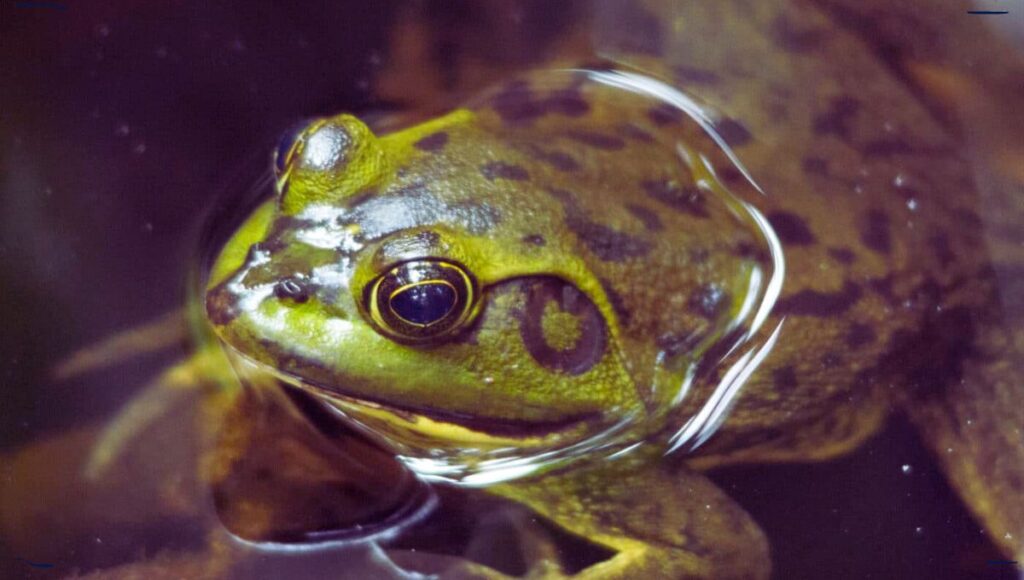Pig frogs, also known as Lagoon frogs or Southern Bullfrogs are vertebrates that can adapt to both land and water equally. Norwegian-American naturalist Leonhard Stejneger first named the frog species Pig frogs in 1901 as the frogs emit grunting sounds like pigs during the breeding seasons (April-August). But are Pig Frogs or Southern Bullfrogs good pets for beginners? Let’s find out.

Table of Contents
Everything About Pig Frogs:
In a Glimpse:
| Common Name | Pig Frogs |
| Scientific Name | Lithobates grylio |
| Other Names | Lagoon Frogs, Southern Bullfrogs |
| Maximum Length | 3.25-6.5 inches |
| Maximum Weight | N/A |
| Ranges | North America |
| Habitat | Warm and moist wetlands |
| Diet | Carnivore |
| IUCN Status | Least Concern |
| Lifespan | 4-6 years |
Geographical Range:
Pig frogs are native to the southeastern coasts of the United States parts of America (similar to Barking tree frogs). The frog species are found between southern parts of South Carolina and Florida, including Texas, Mississippi, Alabama, Louisiana, and Georgia. Southern Bullfrogs were also introduced in China, the Bahamas, and Puerto Rico (Caribbean islands).
Habitat:
Pig frogs are almost aquatic amphibians that prefer a variety of wetland habitats such as open, large, temporary, or permanent pools, ponds, lakes, marshes, or swamps. They are also found on the banks of streams and rivers. Southern Bullfrogs are usually found in freshwater but they can also adapt to moderate saline brackish water.
Physical Description: How do you identify a Southern Bullfrog?

Pig frogs are green or grey-green with brown or black mottling on the dorsal surface. These frogs have fully webbed feet which help them to swim, sharp-pointed noses, and large tympana or eardrums. The frogs share a similar geographic range with American Bullfrogs, and often closely resemble them.
Sexual dimorphism is present among Pig frogs as females tend to be larger than males. The average size of the frogs is 3.25-6.5 inches (8.3-16.5 cm) and a young frog weighs around 20 grams. Till maturity, it is very difficult to differentiate between males and females but after maturity, they can be differentiated easily by males’ bright yellow throats. Their smooth skins allow them to show heterothermic features in which the frogs can vary their body temperature according to their surroundings.
Are Pig Frogs Poisonous?
No, Pig frogs are not poisonous at all. The frogs don’t have any specific glands that allow them to release any kind of toxic substance from their body. In the southeastern United States, where these frogs are abundant, people consider their legs a delicious food source. However, similar to other bullfrogs, Southern Bullfrogs tend to bite very hard to defend themselves from predators. However, the frogs secrete a musty, bitter-tasting mucus, which is non-toxic but bitter, and it forces the predator to release the frogs.
Behaviour:
The amphibians are mostly aquatic by nature and live entirely in wetlands. When one wetland becomes dry, Pig frogs switch to another wetland by hopping, leaping, and swimming. These frogs burrow into the mud when the environment is dry until rain comes and the wetland becomes saturated again. Not only during dry seasons, Southern Bullfrogs also burrow into mud during winter seasons (November-March) to hibernate in colder regions.
Are Pig Frogs aggressive?
Yes, similar to other bullfrogs, Pig frogs are aggressive, and often males fight with other males for territory and mating rights. However, they don’t usually attack humans or other animals unless they are bothered by them.
Reproductive Behaviour:

Southern Bullfrogs are polygynandrous (males and females have multiple mating partners) and their breeding season is usually April-August. Males usually call from the water to the females who are located at the banks. Females also emit a reply call to answer the males and the males then use inguinal amplexus for external fertilizations.
After amplexus, the males and females deposit a clutch of eggs (up to 10,000 at a time on the water’s surface) and leave the place without providing further care. In a couple of days, eggs are hatched and within one and half years, they begin to metamorphosis.
Hunting Behaviour:
Southern Bullfrogs are opportunistic predators that sit and wait for prey for a long time. These frogs hunt at night being nocturnal and wait for prey in the water. When the prey comes within their reach, these frogs leap using their strong hind legs and catch them.
Vocalizations:
Despite being nocturnal, Pig frogs call during the day. As the name suggests, these frogs emit short and loud pig-like grunts in chorus. When the grunts combine, they sound like a roar. During breeding seasons, the male Southern Bullfrogs call their mates from the water and the females reply with a call. Both of these calls are inaudible to humans. These frogs have sharp eyesight which helps them to find prey, predators, and mates.
Physical Activities:
Pig frogs can’t run well but they can hop and leap. These frogs can also jump 100-300 cm deep into the water. Due to their webbed toes, Southern Bullfrogs are excellent swimmers, and during breeding seasons, the males on average drift out 40 meters from the shoreline into a body of water to find their female mates. The frogs can’t climb trees but they can burrow into mud.
Diet:

Pig frogs are opportunistic predators and completely carnivorous. In the wild, Crawfish is their primary diet. Like any other bullfrog, Southern Bullfrogs consume everything that they can swallow. These frogs consume a variety of prey (which changes with seasons and availability of food) beetles, dragonflies, crayfish, and other aquatic invertebrates. They can also feed on fish and other amphibians and frogs occasionally.
Predators:
Large water snakes (such as cottonmouths), prey birds (such as ibises, and ospreys), and American alligators. Bullfrogs and humans are Pig frog’s main predators. To avoid predation, the frogs show camouflage and change their body colour. Unlike other bullfrogs, Southern Bullfrogs emit a musty, bitter-tasting mucus, (which is not poisonous) that forces the predator to release them.
Conservation Status:
However, the IUCN Red List of Threatened Species listed the frog species as “Least Concern” but also accepted the fact that their population in the wild is decreasing due to human interference and wetland destructions.
Disease:
Parasites such as nematodes and trematodes often attack Pig frogs. Like other bullfrogs, these frogs are also carriers of chytrid fungus.
Lifespan:
The information about their lifespan in the wild is very limited but it is believed Pig frogs live 4-6 years in the wild. In captive care, they can live even longer.
Ecological Importance:
Pig frogs can be used in pest control as they consume insects and worms. However, they are very important to balance wetland ecosystems. Many people consume these frogs’ legs for nutritional value. In the state of Louisiana, you need a fishing license to hunt these frogs.
Are Pig Frogs good pets?
Pig frogs can be very unique and unusual choice for pets. The frogs are solitary, nocturnal, and entirely aquatic amphibians. Hence, they require a certain environment to thrive and as an owner, you must provide them with that certain environment.

Being jungle frogs, they are easy to care for and low-maintenance frogs (once you set up their habitats) but creating such an environment and nurturing them in that aquatic environment can be a tricky process for a beginner who doesn’t have much experience with other frogs.
If you have a family and kids at your home, keep your kids away from the frogs as Southern Bullfrogs can bite strongly which may cause medical attention. Being solitary by nature, the frogs neither prefer human handling nor living with other amphibians.
Additionally, almost the whole year they sound like pig grunts which is very loud and unpleasant. Hence, you have to be ready for these challenges if you have already decided to have a Pig frog as a pet.
How do you buy a Pig frog?
Pig frogs are not easily available in the pet market. However, you may find them in the illegal pet markets, but it is advised to avoid them as most of those frogs are illegally captured and unhealthy. You can order or buy them from a reputed breeder or pet shop that can ensure you a frog kept and bred in captivity. Additionally, ask for proof of origin as well as a health certificate while buying the frog.
It is very important to know legal restrictions or laws about that animal at your place if that particular animal is banned from keeping as a pet in your country, and Southern Bullfrogs are no exception (most probably they are not banned). You can also check online platforms for buying them but check for reviews, policies, and other important information before proceedings.
The price of the frogs depends on their availability and your location. You may expect to spend at least $50 for these frogs depending on your location.
Requirement and Care:
Enclosure:
A ten-gallon terrarium tank with a secure lid and proper ventilation system is needed to house a Pig frog. However, the bigger tank is the better for the frogs. You need to ensure 89-90% of the tank is filled with dechlorinated water and only 10-20% will be land area.
Being an aquatic amphibian, these frogs can’t survive without water. Hence, always ensure there is enough amount of water in the tank. If you can create an artificial pool inside the tank it’ll be the best for Southern Bullfrogs.
You’ll need a water dish to feed them and 50% of the water should be changed regularly. You can decorate the tank with some live or artificial plants to make the frog comfortable with the environment. The plants will give the frog space to hide and communicate.
You’ll need a strong glass terrarium so you can monitor the Pig frog’s activities. For this purpose, we suggest you have a Zilla 10 Gallon Pet Reptile Starter Habitat Kit which is perfect for the tropical frogs where they can feel comfortable and secure. It has a secure lid alongside a fresh air screen cover which helps in ventilation. Additionally, you’ll get a 5.5″ reflective dome light fixture, white spot bulb, small heat mat, green terrarium liner, and humidity/temperature gauge with the tank.
Substrate:
Being an aquatic amphibian, Southern Bullfrogs prefer moist environments. Hence, you must have a substrate that can hold moisture for a long time. You can use sphagnum moss, coco fibre, or a mixture of soil and coco fibre as substrate as they can hold moisture for a long time. However, artificial substrates are equally good as well but you can’t plant live plants in artificial substrates. The substrate must be 2-3 inches thick, so the Pig frog can burrow easily.
In our opinion, natural substrates are best if you can arrange them and it is cheap too. But if you don’t have any option to arrange them, you can try Josh’s Frogs BioBedding Tropical Bioactive Substrate, which is clean, eco-friendly, attractive, natural, and perfect for dwelling pets. You can grow live plants on this substrate and you don’t need to change it for years.
Temperature and Humidity:
Pig frogs require warm temperatures and highly humid conditions to thrive. They need 70-80°F temperature inside the enclosure and at night, a little bit cooler. The frog species doesn’t prefer cool temperatures usually hence always monitor the temperature of the enclosure using a thermometer. If the enclosure is cool, use a heat mat or heat lamp to warm them.

As previously said, Southern Bullfrogs require 80-100% humidity level because they cannot thrive in dry environments. When the environment is dry, they burrow into the mud and hibernate to get some moisture. As an owner, it will be your responsibility to provide them with proper humidity either by using a fogger or you can sprinkle water several times a day.
Light:
Like other amphibians, Pig frogs also require a 12-hour day-night circle to maintain their regular activities. You can use a low-wattage fluorescent blub or UVA/UVB bulb to provide them with sufficient light. It is advised to have a 50W Reptile Heat Lamp, a UVA UVB Reptile Heating Lamp with 2 Basking Bulbs, which will provide sufficient vitamin D to the frogs that they don’t receive from sunlight. These heat lamps are widely used, flexible in design, easy to use, and also have dimmable switches.
Food and Supplements:
Pig frogs are carnivorous and you can feed them with gut-loaded crickets, waxworms, mealworms, superworms, crawfish, spiders, and other insects. You can feed an adult frog every other day but you need to feed the tadpoles daily. 3-4 gut-loaded crickets at a time will be sufficient for the adults based on their size, maturity, health conditions, and appetite level. Always use dechlorinated water inside the enclosure.
As the frogs don’t get exposure to sunlight, they lack enough calcium and vitamin D. Hence, you need to dust their food once a week with calcium and vitamin supplements to provide them with proper nutrition.
Cleaning:
You must clean the water dish, dead insects, and waste food from the enclosure regularly to avoid any bacterial or fungal growth. Once a month deep clean the tank with mild disinfectant and rinse it thoroughly with dechlorinated water.
We suggest using Premium Oxyfresh Terrarium Cleaners while cleaning the tank as they are quick and easy to use, safe for the Pig frogs, eliminate bad smells and are also great for the substrate.
Handling:
Similar to other bullfrogs, Pig frogs don’t like handling. If you touch them unnecessarily, they will be stressed and can even bite you. Their bite is very strong and powerful. Hence, it is advised not to touch them unnecessarily and to use gloves while touching them.
Remember with proper care, Pig frogs can live up to 10 years in captivity.
FAQs:
Can you keep two Pig frogs in the same tank?
Pig frogs defend their territory aggressively (especially the males) and also they often fight over territory and mating rights. Hence, it is advised not to keep two Pig frogs in the same enclosure or one might kill another.
Can you keep Pig frogs with other frogs in the same tank?
It is not a good idea to cohabit Pig frogs with other frogs because these frogs can kill and consume the other smaller frogs and also if the other frogs are toxic by nature, they might harm the pig frog.
Reference: Wikipedia.
Also Read: Is American Bullfrog Banned as Pet? Top 11 Differences with African Bullfrogs
Also Read: Are Pixie Frogs (African Bullfrogs) Good Pets? Everything You Should Know Before Purchasing
Also Read: Are Vietnamese Mossy Frogs Good Pets? Your Perfect Pet Guide